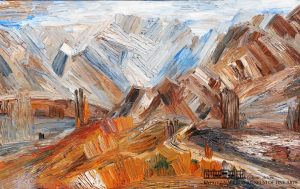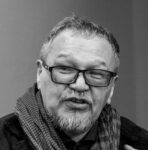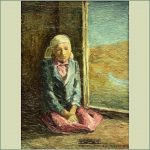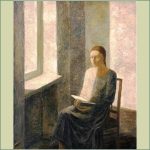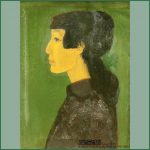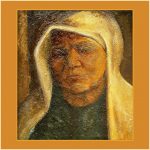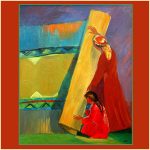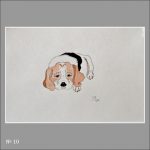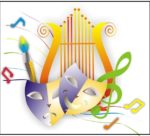 We continue to acquaint you with the collection of works by artists of Kyrgyzstan from the collection of the Kyrgyz Museum of Fine Arts named after Gapar Aitiev through the eyes of art historian Gamal Bokonbaev. Do you see something different in these works? Or, on the contrary, do you fully agree with the opinion of a professional art critic? Maybe his point of view helps you see something you did not notice before?
We continue to acquaint you with the collection of works by artists of Kyrgyzstan from the collection of the Kyrgyz Museum of Fine Arts named after Gapar Aitiev through the eyes of art historian Gamal Bokonbaev. Do you see something different in these works? Or, on the contrary, do you fully agree with the opinion of a professional art critic? Maybe his point of view helps you see something you did not notice before?
Sabitjan Bakashev (1941-1988) – Kyrgyz Soviet muralist, painter. Born in Ak-Terek village, Ton district, Issyk-Kul region. He graduated from the Frunze Art College (1957-1960), the Leningrad Higher Art and Industrial School named after Mukhina workshop of A.K. Kazantsev (1960-1966). He took part in exhibitions since 1960 (from the age of 19), became a member of the Union of Artists since 1967.
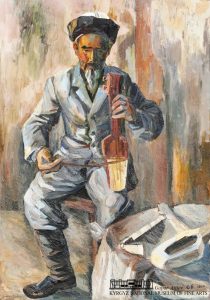 Usta Sabyr. 129×89, 1977.
Usta Sabyr. 129×89, 1977.
I remember the triptych “Usta*” by Suimenkul Chokmorov in 1984. Chokmorov has an abundance of objects, and this is justified: the image appears from the multitude. However, this work is done differently: only those objects are presented that reveal the meaning of what is happening. Before us is a specific person, a master in the manufacture of kyyak – a national bowed instrument. He is dressed in everyday work clothes: a suit-trousers, a kalpak** on his head, boots on his feet. Sits on a chair and plays, listens to the sound. Nearby on the table are a workpiece and an adze. Abstract background. And that is all! Nothing extra, distracting. We do not even see all the legs of the chair (stool). Critics have a place to roam: “I don’t see four legs!”. Is it really that important? The artist showed us the essence of what is happening – the workpiece has yet to become a musical instrument. The master, before continuing to work, listens intently to the sound of an already finished instrument. Doubts: “Am I on the right track? Is it too late to fix? We must do better! So that the sound conveys the soul of the people!”… The picture is not words, not literature. The artist conveys his thoughts through painting. Sound is the energy of the primitive. Everything ingenious is simple, and the master will not show off. No decor! Art is a brutal construct. This is concentration! This abstraction from the rest of the world! Aksakal does not sit on a chair – he got up from tension. Оld age is receding mangled by hard work.
* Usta – master (Kyrgyz)
**Kalpak – traditional male headdress
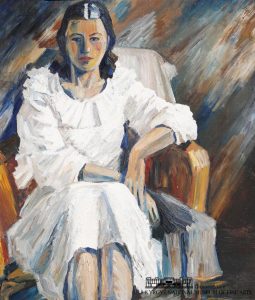 Portrait in white. Canvas, oil, 100.2×84.8.
Portrait in white. Canvas, oil, 100.2×84.8.
A woman in a white dress is sitting in an easy chair with a cape, resting her hands on a wooden armrest. Beautiful, strict, elegant. Strong and tall, judging by the proportions. The axis of the composition is shifted to the left, an abstract background opens on the right. The background becomes an important element of the composition! Dynamic strokes set off the restraint of the figure and face. The head rests on the edge of the picture and the bottom of the figure is cut off, the feet are not visible. The main thing is a white dress! And, of course, the face! Dark skin, black hair, black eyes… blue whites of the eyes make white even whiter. Made generalized, monumental and, at the same time, the portrait is deeply individual. We know her! Seen recently! We do not remember where! So the typical is exactly guessed. Is the typical also an element of composition? Difficult to say, too difficult…. And we don’t know anything about her. Gaze. Perhaps she is an athlete and may have worn a white dress for the first time in her life. Is mourning over? Paphos collar with ruffles. The neck gives out tension, the tension in closed knees. Feeling out of place? But with what dignity! With the dignity of a queen! Portrait in white – Goddess of purity! Is it a symbol? Maiden Goddess? Or, nevertheless, – the Eternal bride?
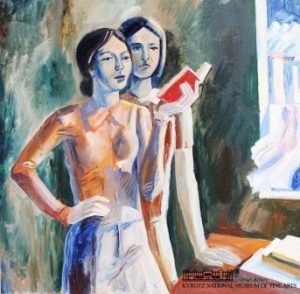 Poetry. Canvas, oil, 100×100, 1978.
Poetry. Canvas, oil, 100×100, 1978.
In the classroom, two students, young and slender girls, are standing at the table. One has a small red book in her hand, she reads poetry at a seminar on the elimination of poetic illiteracy. She is wearing an orange blouse and a blue skirt. Behind her is a friend in a brown dress. The window is open, the curtains are fluttering in a fresh breeze. Wide strokes indicate the space of the room, laconic lines are drawn: figures, a window, a table and books on the table. Strokes indicate details of faces, folds of clothing. Dark walls do not appear black and they amplify the light. Blue shadows are not cold – they are purity and freshness. And even brown looks uncharacteristic here – light, elegant. Written without academic undertakings, but this is not agitation or propaganda. And not monumental painting. This is poetry! The charm of youth, romance, enthusiasm and energy. And a beautiful… pose. This is not yet faith – a painted passion, this is not yet love – a picturesque love. Girls are in love with poetry and infect others with their enthusiasm. For just one minute you stop being illiterate and believe that the main thing in this world is poetry! Poems about ideal love, unrealizable hope, about fabulous faith!
 News. Oil on canvas, 178.5×199, 1969.
News. Oil on canvas, 178.5×199, 1969.
The well-known art critic Olga Popova writes the following about this work: “… the painting “Vesti”, dedicated to Kyrgyzstan during the Great Patriotic War, is restrained in color. She, like other paintings by Bakashev, according to a generalized conditional the nature of the interpretation of the landscape environment and human images is close to the style of monumental painting of this period, but it has the power of deep emotional impact inherent in the easel* painting. It harmoniously developed the color scheme, subtly emphasized the musicality of the linear movement, which achieved the plastic integrity of the canvas. A good knowledge of the national character and ethnographic realities contributed to the creation of a truthful and deep artistic image in the decorative and monumental plan.
In a remote mountain camp, jailoo, there is no radio and the residents receive news from the front from newspapers. Reads the newspaper to the assembled invalid of the war. He sits on a stump, with his back to the viewer, holding a newspaper in his hands, holding a crutch with his elbow. His dark overcoat stands out – this is the center of the composition. The reader and riders form a strong diagonal. The white felt of the yurt, the white shirt of the boy, the white newspaper and the white foal – these light spots create the necessary static. Play their role, and the contours of the mountains, and the sun at sunset. Fifteen people gathered: mostly old people, women, children. They stand tight, together. The old men are dressed in dark clothes and the women are lighter. All focused listening, sad and different. A guy, already of draft age, attracts the eye, and the girl does not take her eyes off him … The groom? Betrothed? Why did the white foal hide its muzzle behind the old man’s chapan? Why did the artist depict him like this? A little ugly. The animal does not understand what is happening? Why show it in full? And half of the horse disappeared somewhere. The artist illuminated the figures and faces according to the plan, and this inner light coming from everywhere gives the picture an optimistic sound.
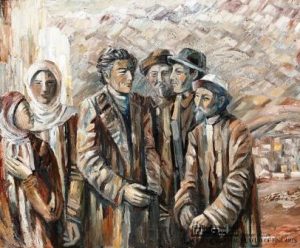 Ak-Terek people are my countrymen. Canvas, oil, 136×165, 1984.
Ak-Terek people are my countrymen. Canvas, oil, 136×165, 1984.
A well-known artist in a fashionable leather coat and a white turtleneck came to his native village and greeted his fellow villagers. Talk about your successes! The old people listen to him with disbelief: one, with a drooping look, maintains an impassive expression on his face; the other stands behind everyone and hides great doubts behind a smile. A young man, wearing a hat, representative of the rural intelligentsia, probably a teacher, openly rejoices. An older woman supports him and approves and admires him. The beauty stared straight at the viewer (or at someone else?), but she is dreaming about something of her own, and her gaze wanders in far-reaching plans…. The group is moved to the left to show the edge of the village in the distance. Sheep graze on the outskirts. Roofs turn white among dense monochromatic greenery. This happens in early autumn. And it’s getting colder. Women are wrapped in long white scarves. And the men are dressed warmly…. What are you talking about? Perhaps the collective farmers ask: “Do they pay well? More than bosses? For what? Art? Culture? Ah-ah-ah! Then work, dzhigit! And don’t forget us”. Countrymen should not be forgotten, you need to stick to the roots. It is necessary to preserve traditions and develop modernity. The artist asserts himself: he is not a boss, not a party member, not a prosecutor, and, nevertheless, he lives well and enjoys the respect of people and the authorities highly appreciate him. For what? We have the power of culture in our country! Art! The power of the human spirit! …. Now we do not even dream about it. And the villagers again ask a quite reasonable question: “What should artists be paid for?” And there is nothing to answer? You can mumble something about the future, when there will be a complete merger of the city and the countryside…
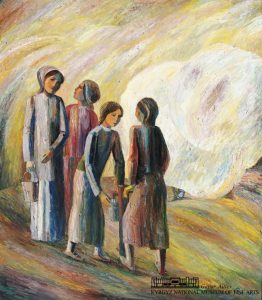 At the spring. Canvas, oil, 150×120, 1980.
At the spring. Canvas, oil, 150×120, 1980.
Two girls and two women are standing near the artesian water intake. They are dressed in the simplest peasant clothes, long and closed. One woman has a bucket in her hands, another bucket is filled with water. They came in pairs for water. Seniors and juniors. The environment is marked very conditionally. The space is rounded with textured strokes around the tree. The crown is like a white cloud. Apricot blooms! Spring! Four figures landed from the semicircle, stand on an inclined plane and now disappear again into the whirlwind of the universe. The composition is fantastic! But ideologically sustained. The author wants to tell us about how good it became in the villages: they drilled deep wells and provided the population with clean water. The population thanks the government. They gather in the spring at the column and chirp merrily. What else is needed for complete happiness? The figures are deliberately primitive. And thoughts are primitive …. No matter how! How they talk! One woman pities the other, almost crying from indignation and humiliation. And the girl finds out what she doesn’t like. Became strict, like a sparrow. It turns out that everything else – water, spring, composition – is twisted around this spiritual center! Back to primitivism! To the proto-renaissance! To Giotto*!
* Giotto di Bondone (1266-1337) – Italian painter and architect of the XIV century, one of the first representatives of the proto-Renaissance **
. A key figure in the history of Western European art. Overcoming the previous Byzantine icon-painting tradition, Giotto became the founder of the Italian school of painting, developed a new approach to depicting space. Giotto’s works were inspired by Leonardo da Vinci, Raphael Santi, Michelangelo Buonarroti.
** Proto-Renaissance – a stage in the history of Italian culture preceding the Renaissance, that is, the Renaissance.
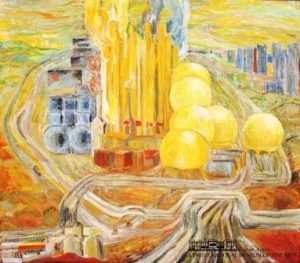 Oil pipeline “Druzhba” (Friendship). Oil on canvas, 138×157.5, 1975.
Oil pipeline “Druzhba” (Friendship). Oil on canvas, 138×157.5, 1975.
Druzhba is the world’s largest system of main oil pipelines. It was built in the distant 60s, it delivered oil from the USSR to Europe! Before us is a part of this system – an oil refinery. It is surrounded by pipes and roads, they enter from the right and go down. Where? Where? Where is all this located? It doesn’t matter. This is an abstract creation of human hands on planet Earth! Cylindrical tanks, spherical installations, parallelepipeds of workshop buildings, some tall technological devices. In general, the socialist realist production theme …. But in the 70s, the production theme changed! And the author brilliantly noticed it. In the center are red flags, administrative buildings and … personal cars. These bosses drove right into the factory area. The path of the workers is quite different. From multi-storey microdistricts, by bus, to a public transport stop. And from there on foot, through the crossroads. The pipes bent to let the colorful ants into the belly of the monster, the road goes underground…. The yellow signal coloring dominates, contrasting with the color of the gray-blue concrete buildings, but the overall tone of the work is pale. This is done so that we see the main thing – people and feel the human scale …. Now the Druzhba oil pipeline is perceived differently. Oil needle of Russia! Gas noose of the West! Not Friendship – Enmity! Back in 1975, the artist was in happy ignorance, but ingeniously felt the basic contradiction: a person is crushed by the monstrous scale of his fantastically crazy activity.
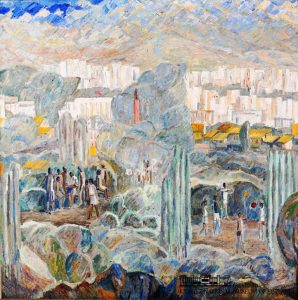 My city. Oil on canvas, 149×149, 1978.
My city. Oil on canvas, 149×149, 1978.
Under the mountains there are white panels of microdistricts, they soar like clouds in the sky! In the very center, surrounded by greenery, there is a bronze monument on a granite pedestal. This is not a specific hero! The characteristic gesture of the leader of the world proletariat is not visible! According to the author’s concept, in the center of a socialist city, people should sing the exploits of abstract fighters for the happiness of the working people. There is also a building with a portico and a red flag. It conditionally denotes the White House of the leaders of the city and the country. The roofs of the old city are turning yellow, they have their own long history! Vertical poplars seem to imitate a granite pedestal. And willows, elms, lindens, maples, arborvitae … trees and shrubs form a continuous green thicket. In small glades, the townspeople have a cultural rest: young people play ball; old people are having leisurely conversations; the lovers retired to the depths of the garden. Not enough blue fountains. There are no reservoirs and rivers either, probably they did not fit into the author’s concept. Indeed, in our city there are no normal embankments and well-groomed reservoirs. By the way, subtle criticism of individual omissions … The overall tone of the work is pale, green-blue. And they add saturation: blue sky-mountains at the very edge of the picture, ribbons of white buildings at the top, dashes of yellow roofs in the middle, and ridges of dark mountains below. A talented artist put it all together and created a feeling of harmony, happiness, and the future! Made with soul, talented, and too … approximately, too conditional. In the 70s, artists began to use the methods of monumental painting in easel paintings. Most likely, this design sketch was not approved by the artistic council: they did not accept the subtle criticism of the lack of normal embankments and well-groomed reservoirs. And the performer, without thinking twice, turned the labor expended into a museum exhibit.
 Spring. Oil on canvas, 104.3×129.3, 1974.
Spring. Oil on canvas, 104.3×129.3, 1974.
A group of young people gathered near a bench in a flowering park. Three boys and four girls. Three are sitting, two have turned their backs to the viewer, forming a depth. If you see here only the verticals of the figures, the horizontal of the bench, the diagonals of the eyes and the color accent of the scarf, it will be boring. Interesting… wordless conversation…. Let’s start with the girl in the red scarf. She does not look at anyone, she droops sadly, but her whole figure whispers about something very important to the guy in the yellow sweater. And he, the bastard, does not notice her and looks up at the light green shoots in the hands of a girl in blue. Both coo with tender leaves and try to hide what cannot be hidden. The guy in blue is silent, sitting with his back to the viewer and to the girl in the red scarf. He cannot choose. It seems that all his sympathies are for blue, but he also likes the girl in the sleeveless jacket. And happiness can be … behind your back. And the girl in the sleeveless jacket turns to the guy in the brown jumper. And he, the bastard, does not notice her, sat down next to her on the bench, folded his arms on his chest and looked defiantly at the girl in the red scarf, as if shouting about his feelings! The polygon is closed. Remained outside the group As a girl in white, she clearly wants to join the general conversation and seems to be formally included (in all diagonals and verticals of the composition), but she is superfluous here.
The talented muralist turned out to be a brilliant playwright. We called it literary and were mistaken. We decided that abstract aggression and senseless exaltation were enough, and we lost the ability to speak concretely. About spring provocateur! About unrequited love, deceitful happiness and the paradoxes of creativity.
 Day of rest. Oil on canvas, 70×91, 1974.
Day of rest. Oil on canvas, 70×91, 1974.
City landscape, impression from abroad. Perhaps it was a creative business trip to the Baltic states, or perhaps to one of the countries of the socialist Commonwealth. Dark, damp ground: after rain, a small puddle glistens. The lack of greenery becomes a frightening symbol. The red roof and red walls look like red ocher, tiles, bricks. Dense historical buildings, nothing remarkable. Flared jeans, colorful clothes, a man in a white coat with a white poodle on a leash. It’s all so simple… and different. Desirable foreign land! Suprematism of the streets, minimalist design and brutal texture. The windowless wall is plastered with vertical strokes, while the sky and earth are horizontal. The empty wall dominates! The empty square dominates! And the red planes, together with colored figures, create a toy mood of aniline modernity. Dark passages hint at the perspective and the metaphysics of space! … I wanted to make our domestic artist a Euro-picture – and I did it! Understood their compositional paradoxes perfectly well! Appreciate the beauty of the empty walls! Poetry of pure lines! Genius flat planes! But the pedestrians turned out to be too straightforward. They do not rest – the refined products of their soulless urbanization are in a hurry somewhere. But the absence of trees is scary, is it really going to be the same with us?
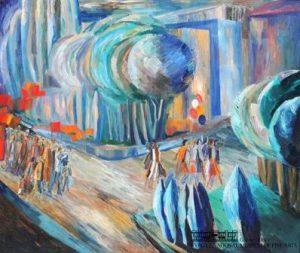 Festive morning. Oil on canvas, 128.5×148.5, 1980.
Festive morning. Oil on canvas, 128.5×148.5, 1980.
From the very early morning, well-dressed people voluntarily-compulsorily go to the central square of the capital to greet their leaders, their guiding and guiding force. They go under red banners, slogans, balloons. By balloons, by greenery, by clothes, you can determine that this is a May Day demonstration! Red is the color of ideology. There is very little of it. He accentuates! Green-blue is the color of early morning, the color of spring greenery and inexplicable joy! He dominates. Ocher and shades of brown are the color of the human flow, it flows and vibrates! Trees and buildings are large volumes, and people with their agitation are small details. The sun has not yet risen, or maybe it is covered by clouds, and the colors seem to glow surrounded by complementary shades. And the light comes from where it is necessary, according to compositional necessity. Poplars stretched out, willows and maples spun, arborvitae spun. A slogan artist could show what holiday he means, but he doesn’t. He draws a fresh morning, and how great it is when people, adults and children, get together and walk around their hometown. Ahead, girls are walking in a cheerful flock, all in skirts. Behind them are the rest, and one cheerful uncle shows Vladimir Ilyich Lenin with a gesture: “Everyone after the girls! Comrades, you are on the right path!” … The artist camouflaged his irony a bit. Although in the 80s no one hid the irony. A talented artist makes us take a broader look at the festive morning in the USSR.
 Panfilov street. Canvas, oil, 110×85, 1970.
Panfilov street. Canvas, oil, 110×85, 1970.
One can only guess what place is depicted in the picture. Most likely, it is somewhere between Kievskaya and Toktogul. This is a small square, which in the 80s became the courtyard of the clinic. Now this place is fenced off and is called the “Clinical Hospital for the Administration of the President and the Government of the Kyrgyz Republic.” But perhaps a different place is depicted. A lot has changed in the city, new buildings have appeared, and some have been demolished. And there are more cars now. And the artist depicts them deliberately small in comparison with passers-by and a cyclist. This is the position! May rains, greenery of a timidly pale color appeared, surrounded by light gray, brick ocher red stands out with accents. It is so light and transparent after a spring rain, when you breathe easily, and you look at the beauty with wide open eyes, without squinting, it’s great, it’s health. The brightened sky is reflected on the wet pavement and… the spirit of the city, which cannot be described in words… In modern times, the street has remained the street named after Ivan Vasilievich Panfilov, a famous military leader, Hero of the Soviet Union. In October 1938, Ivan Vasilyevich was appointed to the city of Frunze to the post of military commissar of the Kirghiz SSR. Perhaps he lived on this street, which used to be called Sadovaya. In 1941, under his leadership, the 316th Rifle Division was formed. Recruited from residents of Almaty, Almaty region and Frunze. On October 10, 1941, the 316th division entered into battle with enemy troops and was able to inflict significant damage on it.
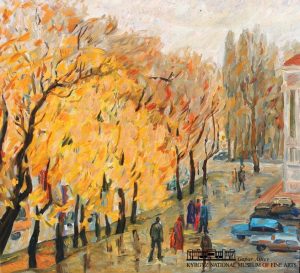 XXII Syezd (Congress) street. Oil on canvas, 110×119.5, 1971.
XXII Syezd (Congress) street. Oil on canvas, 110×119.5, 1971.
Frunze urban landscape of the 70s. Recognizable crossroads, Chui-Tynystanov a, and the view from the workshop, most likely from the second floor of the “Artist’s House”. Nothing changed. The names have changed frequently. In 1924, Kupecheskaya Street was renamed Grazhdanskaya, in 1936 – Stalin Street, and in 1961 – XXII Party Congress Street. Already after the creation of the picture, in 1974, it became Leninsky Prospekt. After the formation of the Kyrgyz Republic, Chui Avenue appeared. Tynystanov Street used to be called Krasnooktyabrskaya…. Autumn, the leaves on the trees turned yellow and reddened a little, and filled most of the picture. Trees dominate in color, shape and size. Actually, the street itself is visible only in the gaps between the brown trunks. The alley along the Ministry of Economy is clearly visible. People are walking along it. It has rained, and the wet asphalt reflects the sky, trunks and leaves. Closer to the building is a parking lot with four cars. Now there are many more of them! Do not fit! They took up most of the alley! And the artist’s people are more significant than machines, larger. He deliberately made cars toy and specifically applied a reverse perspective. And the most important thing for an artist is trees. Now it’s the other way around: first cars, then people, and only then trees…. In such works, artists “write” the history of the city. The history of buildings, streets, trees and people. The history of the spirit of the city, its moods and preferences.
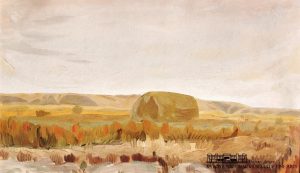 Autumn steppe. Oil on cardboard, 40.6×68.3, 1971.
Autumn steppe. Oil on cardboard, 40.6×68.3, 1971.
Autumn steppe. Steppe in autumn. The work is named literally: as the artist wrote by hand on the back of the cardboard, so it is named. The master of contrasts and dissonances appears in this work as a singer of the finest nuances! Autumn steppe in shades of ocher. The sky is overcast with gray clouds: the bleached ocher is given off by a distant echo of violet. Low hills, a lonely haystack are visible. Shrubs add red and brown ocher. There are small strips of earth, yellow and green. And that’s all! Why is such a pale landscape, monotonous, monotonous in color, so interesting? It’s all about the shape of the spots! Bizarre shapes are stretched into horizontal rhythms. From above, the shady slopes of the mountains playfully dance. In the middle, a haystack dominates, trees sing along with it. Each spot is meaningful, they are exactly what they should be. Written accurately, neatly and beautifully. Vertical strokes lined up closer to the viewer. They lean in different directions, as if performing rhythmic movements, as if dancing! Maybe? Does the name literally mean autumn steppe? That is dance? Tap dancing? … But this is hardly …. And yet, the words “rhythm” and “dance” accurately define the merits of this composition. The artist coped with the most difficult task: he made the nuance temperamental!
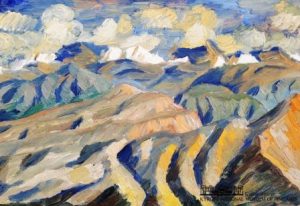 Etude. The mountains. Oil on cardboard, 34.2×49.7, 1979.
Etude. The mountains. Oil on cardboard, 34.2×49.7, 1979.
The author achieved what he wanted and stopped. Further detailing will not improve the work – it will only worsen it. The freshness of the impression, the purity of the color, the original sound will disappear. And why do they appear? From a combination of warm and cold shades? White inclusions? From the texture of strokes? Trembling in the wind, like life itself …. Frosty blue peeps between warm clouds. Snow on the peaks. Illuminated slopes – shades of ocher and green; shadows are blue and blue. Closer to us, the shadows turn black, the slopes brighten, orange is added. The artist caught the air. This is impressionism! But somewhat different: there is less artistry in brush movements, the strokes are wide, harsh, brutal. This is ours and others, great and toy, inspires us … and leaves us indifferent. Difficult feelings! Maybe it’s because we have a view from the plane? Most likely. And this is a new topic for painting! Non-standard artistic research and unexpected conclusions. In such a small study – fleetingly about the eternal. The small texture hints at the scale, we see the universal expanses and are no longer afraid. We are above them, we look down, and we are safe, in a comfortable supersonic liner. We fly past eternity.
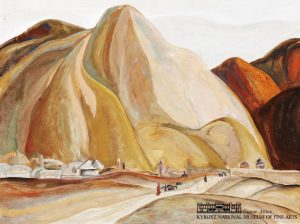 Tone. Oil on canvas, 75×99. The year of creation is unknown.
Tone. Oil on canvas, 75×99. The year of creation is unknown.
The year of creation of the work is unknown, but most likely; this is one of the earliest works of the master. The artist develops, his style, manner changes, this is understandable and natural, and it was and will be so. Many artists of the period of developed socialism worked simultaneously in several formal concepts; moreover, they could be different within the same work. This is normal, this is a creative search and … already postmodernism…. At one time, the well-known art critic Olga Popova, the author of the formal concept, subtly remarked: “In the work of Sabitjan Bakashev, Sagyn Ishenov, Melis Akynbekov, Satar Aitiev, Murat Bekdjanov, a departure from the traditional method of working on paintings is noticeable. As a rule, they create thematic paintings without natural material based on imagination, historical or folklore sources. In this regard, the visual language of this group of artists has changed – it has become more conventional and decorative. Now we will say more simply – postmodern. Peculiar and unique Kyrgyz variation…. The design of the lines, their plasticity have not changed, but the manner is completely different! Mountains and valleys are a monotonous outline of planes for painting in one tone and color. In such manner, the lines look hard, sometimes rough and unaesthetic…. On the contrary, the houses of the village, buildings, haystacks, greenery are made finely and vividly. Transparent shades indicate the people of the car walking along the road. You can see a figure on a horse, sheep are grazing. A subtle play of nuanced transitions and whimsical strokes. It’s aesthetic… Perhaps this is the main feature of the picture! Rigidly drawn mountains, and in contrast, live field observations in a human village? It seems that the master tells us that he can work in any style, build any composition, breaking any boundaries. It becomes an end in itself, it becomes an apology for a formal concept!
Koi-Tash. Oil on canvas, 44.5×69.7, 1986.
The ridges rise from the foothills and bifurcate at a height. Like the wings of a bird. One wing goes to the right, beyond the edge of the picture. The second – to the left, turning into distant snowy peaks. Moreover, the foothills, and the ridges, and the snowy peaks, and even the sky, are deliberately made with large textured strokes, a brush and a palette knife. Moreover, it is strange: we see where it is closer and where it is farther, we physically feel all the turns. The author managed to show us the structure. We understand the geodesy of the area. We see a spatial design – the mountains are like wings, growing in different directions. Small details are inscribed in this extended space: poplars, bushes, a road, a river floodplain. It seems that people are walking along the road, or maybe this is a bush growing. This is how an architect depicts people in a project when he wants to show the customer the real scale. In this case, images have no other meaning. In general, the artist works as an architect, the general masses are important to him. “Small architectural forms” he neglects. “Design” is not involved. After all, a painting, sketch, landscape is, first, space, and not polished details for an illiterate buyer. And masterful expression conveys the essence of reality better! In addition, perhaps … beauty … space. The master worked near the village of Koi-Tash in the Chui region. The village has recently been overgrown with scandals, but this has nothing to do with the picture.
 Konur-Olon. Oil on canvas, 110×169.5, 1981.
Konur-Olon. Oil on canvas, 110×169.5, 1981.
Mountains are torn upward by steep slopes, freezing with ridges that have gained a dangerous height: they can capsize at any moment. This is shown by bold oblique strokes, rising sharply and falling vertically. Part of the breed, frightened, carefully slides down; advances in gentle hills, and already at the bottom there are sloping clearings. Contrasts of tone and color create a hard, rocky texture. Even the trees and shrubs seem to be made of stone. The lines are whimsical, multidirectional, and as a result dutifully fit into the horizontal lines. Therefore, according to the painter, gorges are formed, and the lowlands, processed by man, turn into a road. People ride along the road, on horseback, in cars, go to the valley, at the bottom of which there is a lake. A wonderful view, unusual, from the side of the mountains to the valley below. Usually write the other way around. Two triangles of mountains at the edges – activity and contrasts. The triangle of the valley in the middle is calm. Heavenly strokes march across the back. The nuances depict heavenly pleasures near the water. Moreover, the road has come to the fore! The road has become the center of the composition… and the universe! Not mountains, valleys, lakes. Not the sky! The main thing is the road! This is what the human eye did. The human eye highlighted the letter “S”. He is looking for a dollar and does not find it … KOҢUR-ӨLӨҢ is a village in the Ton district of the Issyk-Kul region. In its vicinity, in the gorge, the artist stopped, admired, and with his talent immortalized the majestic nature, the road, the riders, the car and … himself.
 In the mountains. Oil on canvas, 130.3×149.1, 1980.
In the mountains. Oil on canvas, 130.3×149.1, 1980.
Fields, mountains, peaks. Poplars along the road. Next was the village. Yellowed trees are interspersed with still green ones. Morning, the yellow tractor began autumn plowing. Cirrus clouds dissolve in the blue sky…. When listing the elements, it seems that we have before us a typical mountain landscape, but not everything is so simple… The well-known art critic Olga Popova writes the following about the artist’s landscapes: (he) likes to depict nature, but it appears in a transformed, heavily decorated appearance, and the basis of the compositions is always a realistic, professionally made drawing, only slightly and tastefully stylized, but the color, arbitrarily conditional, bright and elegant, harmoniously built, despite the remoteness from the real color combinations and color saturation of wildlife. The artist simply ignores the boring light-air perspective, banishes the vulgar air haze from his works. He is sure that the colors “taken head-on” (a great sin in academic painting) more fully convey the beauty of the blue sky, motley mountains, and striped fields. In addition, the lines must sing! … The lines of the curved plateau begin to wave, rise, hit hill against hill, and calm down, reaching the serenity of peaked peaks. At the top, they are supported by energetic oblique strokes of steep slopes… Besides, the artist could not do without riddles (h so that art critics do not think life is sugar). What are people doing at the edge of the field? Did they come here in a yellow car? From the village? Celebrating the start of autumn fieldwork. It does not look like agitation is visible. They stand in a row, on their knees. Are they praying? Are they buried? Pray for a good harvest? Some kind of Angelus (Angelus Domini). Kolkhoz? Muslim! Ah! Religious theme in the country of socialist realism! Is that possible! … It seems to me that the artist innocently depicted unreliable people with their ghostly chores (no matter what) in order to convey the mountain scale! A monstrous disproportion. So that it immediately becomes clear: this is about eternity! However, this is transient. And it is about religion again! Ah!
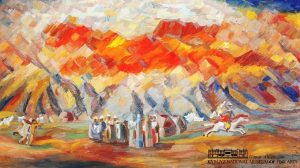 Distribution of the newspaper “Erkin-Too” (Free Mountains). Canvas, oil, 80×140, 1977.
Distribution of the newspaper “Erkin-Too” (Free Mountains). Canvas, oil, 80×140, 1977.
Mountains are sculpted with large strokes; small strokes – people, horses, yurts. Highland pasture meadows are indicated by wavy lines. Everything is shown in a generalized, simple and clear way. On the left, boys run in with newspapers; in the center, jailoo (summer pasture) residents discuss the latest news; on the right, riders ride with information further. And the wind helps them spread white newspaper sheets on the ground. Greenery and earth, red mountains and blue clothes…. Very beautiful monumental … panel! A visible image of the dissemination of information…. The well-known art historian Olga Popova writes about the artists of the 70s as follows: “Almost all of them began with experiments in shaping at the same time as searching for their own themes, and the problems of form were initially placed by them above the problems of content. However, in their best works, they managed to overcome the narrowness of the formalistic concept, creating works that carry a strong intellectual and emotional charge precisely due to the complex figurative structure. … Work on the form develops into work on the content? What could be the content in the USSR? Only socialist! And it sounded something like this: information about the successes of socialist construction is spreading to the most remote corners of our vast country! … The Erkin Too newspaper has been published since 1924. It was renamed Kyzyl Kyrgyzstan (Red Kyrgyzstan), and in 1956 – Soviet Kyrgyzstan (Soviet Kyrgyzstan). Perhaps the picture was made for the anniversary of the elder of the mass media of the republic…. Now we see more, and the bright red mountains remind us of the flag of the Kyrgyz Republic! We see that the Soviet government did not interfere with the patriarchal way of life: men have their own circle, women have their own; Men mostly sit, women stand. No conflict of tradition with modernity! And the socialist content is just an excuse to make a beautiful composition. So what if it looks like a sketch for a decorative panel. From the picture breathes happiness and harmony. And the idea is that people under any power will enjoy life … and including the fact that information now reaches them faster..
Clover field. Oil on canvas, 118×149, 1986.
The artist rose above the clover field and took in the whole universe with his eyes. I saw the entire valley: fields, hills, a lake, mountains, and white clouds above the peaks, and a blue sky behind them. The morning sun colored the tops of the autumn poplars, the houses with yellow roofs. Somewhere in detail (combines are visible), and somewhere generalized (impressionism and abstractionism), and somewhere the image becomes a symbol, a sign. The perspective is broken several times: when you fly, all the rules lose their meaning. Of particular importance is the dynamics of the stroke: color, shape and direction of movement … This is not a salon work, not for sale, not by order. The shadows are too black, the clouds are dirty, and the lake is a blue stripe. Sloppy, hasty. Street artists can lick better. It is so now! Moreover, in the 80s, artists worked freely! And at the exhibitions, desperate courage was appreciated to the end! The state was supportive, and the museum bought, and connoisseurs admired. This is not a monumental painting. And you can’t call an easel painting. How to present it? Decorative abstraction? Picturesque protoplasm? What was in the beginning? Then, when these words still did not make sense? If so, then it is very serious and no name has yet been found for this. And will there be in the future? A special kind of painting flourished in the era of developed socialism. For a brief moment, everything was possible except criticism. And, in fact, painting itself develops and … flies away! Paradox! And another paradox: in the 80s, paintings began to be called composition…
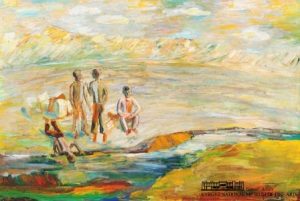 Memory. Canvas, oil, 85×125, 1976.
Memory. Canvas, oil, 85×125, 1976.
A valley surrounded by a semicircle of mountains; a river flowing in the middle. Clouds are running and chasing everyone behind them. The whole rainbow set of colors and shades. Small strokes of various shapes, fragmentation and integrity! Complexity and simplicity! How is this possible? One thing is for sure – a certain surface (combinations of tone, color and shape) denotes a certain matter. Mountains are slanted strokes, valleys are horizontal, people are vertical. Kyrgyz pointillism! The artist does not seek to convey nature literally – he means. And he does it with talent, from imagination and living memories…. The guys are resting, stopped on the way. Huge bags nearby. Maybe they came from the city for the summer holidays ly? And now they will disperse to their native places? Or vice versa? They’re going to study! To the big world! Into a universe of exciting adventures and fantastic opportunities. The two are loudly discussing the prospects that are opening up, making huge plans. The third sits and sadly looks at his native places: what awaits them ahead?.. The fourth lies down and drinks water straight from the river! Either he just dips his face, or he doesn’t strain at all, enjoying life. He is an artist, looks into the reflection! Or the fourth dimension? It is more interesting and richer. He turned over and sees… the true world. With this technique, the artist easily turned our perception upside down, got rid of unnecessary pathos, and added paradox to a simple composition! Here is the main symbol of the picture: all the plans of the guys will turn upside down more than once…. Similar: complex, ambiguous, cheerful, mischievous compositions, the muralist made a significant contribution to the development of Kyrgyz easel art!
<= PART 7 TO BE CONTINUED




